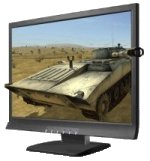.
For the first time, the giant software maker is acknowledging the help of the secretive agency, better known for eavesdropping on foreign officials and, more recently, U.S. citizens as part of the Bush administration’s effort to combat terrorism. The agency said it has helped in the development of the security of Microsoft’s new operating system — the brains of a computer — to protect it from worms, Trojan horses and other insidious computer attackers.
“Our intention is to help everyone with security,” Tony W. Sager, the NSA’s chief of vulnerability analysis and operations group, said yesterday.
The NSA’s impact may be felt widely. Windows commands more than 90 percent of the worldwide market share in desktop operating systems, and Vista, which is set to be released to consumers Jan. 30, is expected to be used by more than 600 million computer users by 2010, according to Al Gillen, an analyst at market research firm International Data.
Microsoft has not promoted the NSA’s contributions, mentioning on its Web site the agency’s role only at the end of its “Windows Vista Security Guide,” which states that the “guide is not intended for home users” but for information and security specialists.
The Redmond, Wash., software maker declined to be specific about the contributions the NSA made to secure the Windows operating system.
The NSA also declined to be specific but said it used two groups — a “red team” and a “blue team” — to test Vista’s security. The red team, for instance, posed as “the determined, technically competent adversary” to disrupt, corrupt or steal information. “They pretend to be bad guys,” Sager said. The blue team helped Defense Department system administrators with Vista’s configuration .
Microsoft said this is not the first time it has sought help from the NSA. For about four years, Microsoft has tapped the spy agency for security expertise in reviewing its operating systems, including the Windows XP consumer version and the Windows Server 2003 for corporate customers.
With hundreds of thousands of Defense Department employees using Microsoft’s software, the NSA realizes that it’s in its own interest to make the product as secure as possible. “It’s partly a recognition that this is a commercial world,” Sager said. “Our customers have spoken.”
Microsoft also has sought the security expertise of other U.S. government and international entities, including NATO. “I cannot mention any of the other international agencies,” said Donald R. Armstrong, senior program manager of Microsoft’s government security program, citing the wishes of those agencies to remain anonymous.
Microsoft’s concerns extend beyond the welfare of its software when it seeks the security expertise of government agencies. “When you get into an environment where a Microsoft product is used in a battlefield situation or a government situation where if a system is compromised, identities could be found out,” and it could be a matter of life and death, Armstrong said.
Other software makers have turned to government agencies for security advice, including Apple, which makes the Mac OS X operating system. “We work with a number of U.S. government agencies on Mac OS X security and collaborated with the NSA on the Mac OS X security configuration guide,” said Apple spokesman Anuj Nayar in an e-mail.
Novell, which sells a Linux-based operating system, also works with government agencies on software security issues, spokesman Bruce Lowry said in an e-mail, “but we’re not in a position to go into specifics of the who, what, when types of questions.”
The NSA declined to comment on its security work with other software firms, but Sager said Microsoft is the only one “with this kind of relationship at this point where there’s an acknowledgment publicly.”
The NSA, which provided its service free, said it was Microsoft’s idea to acknowledge the spy agency’s role.
The NSA’s primary mission is signals intelligence — monitoring the communications of foreign powers, terrorists and others. But its secondary objection is “information assurance,” under which the security of Microsoft’s operating system falls.
Industry observers suggest that both the NSA and Microsoft have good reason to disclose their relationship. For Microsoft, the NSA’s imprimatur may be viewed as a vote of confidence in the operating system’s security.
“I kind of call it a Good Housekeeping seal” of approval, said Michael Cherry, a former Windows program manager who now analyzes the product for Directions on Microsoft, a firm that tracks the software maker.
Cherry says the NSA’s involvement can help counter the perception that Windows is not entirely secure and help create a perception that Microsoft has solved the security problems that have plagued it in the past. “Microsoft also wants to make the case that [the new Windows] more secure than its earlier versions,” he said.
Armstrong, the Microsoft manager, said: “The entire crux of Vista was security. . . . Security is at the forefront of our thoughts and our methods in developments and is critically important to our customers.”
By: Alec Klein and Ellen Nakashima, Washington Post Staff Writers, Tuesday, January 9, 2007
 In a world where online gaming is very common, how do you separate the elite from the newbie’s? Shuttle Computer’s new XPC 1337 products cater towards the most elite gamers seeking the absolute best performance. XPC 1337 systems deliver blazing fast framerate with outstanding visuals in all popular online games including World of Warcraft, Counter Strike, Battlefield and others! These systems aren’t for newbie’s though; only the 1337 gamers can harness the performance of XPC 1337 systems.
In a world where online gaming is very common, how do you separate the elite from the newbie’s? Shuttle Computer’s new XPC 1337 products cater towards the most elite gamers seeking the absolute best performance. XPC 1337 systems deliver blazing fast framerate with outstanding visuals in all popular online games including World of Warcraft, Counter Strike, Battlefield and others! These systems aren’t for newbie’s though; only the 1337 gamers can harness the performance of XPC 1337 systems.

 The Personal Cinema System has a range of potential uses. Content is fed to the headset via the small box you see pictured. Dubbed the Liberator, this box includes two USB ports, a Compact Flash slot and composite, component and S-Video inputs. Thanks to this wide range of connectivity, you could connect your PC (for games, Web browsing etc), video game console, video iPod, DVD players and anything else you can think of really.
The Personal Cinema System has a range of potential uses. Content is fed to the headset via the small box you see pictured. Dubbed the Liberator, this box includes two USB ports, a Compact Flash slot and composite, component and S-Video inputs. Thanks to this wide range of connectivity, you could connect your PC (for games, Web browsing etc), video game console, video iPod, DVD players and anything else you can think of really.